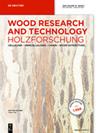Cell wall composition of Camellia oleifera Abel. shell: new insights into its composition distribution and ultrastructure
IF 1.6
3区 农林科学
Q2 FORESTRY
引用次数: 0
Abstract
油茶(Camellia oleifera Abel.
油茶果壳(COS)是一种农业废弃物,每年的产量超过一百万吨。研究人员对 COS 细胞壁的超微结构和木质纤维素成分的分布进行了调查。显微镜结果显示,COS 包含两种类型的细胞,即小叶细胞(SC)和实质细胞(PC)。SC含有50.4%的半纤维素、17.6%的纤维素和30.9%的木质素,而PC含有35.2%的半纤维素、23.7%的纤维素和35.0%的木质素。木质纤维素成分在 COS 中的分布并不均匀。木质素与多糖交替分布在 PC 壁中。在 SC 中,半纤维素主要存在于次生壁 S2 中,而木质素主要存在于复合中层中,纤维素主要存在于次生壁 S3 中。该研究给出了 COS 细胞壁超微结构和木质纤维素分布的综合模型。这项研究提供了对 COS 细胞壁的基本认识,有助于今后对 COS 的分级利用。
本文章由计算机程序翻译,如有差异,请以英文原文为准。
求助全文
约1分钟内获得全文
求助全文
来源期刊

Holzforschung
工程技术-材料科学:纸与木材
CiteScore
4.60
自引率
4.20%
发文量
83
审稿时长
3.3 months
期刊介绍:
Holzforschung is an international scholarly journal that publishes cutting-edge research on the biology, chemistry, physics and technology of wood and wood components. High quality papers about biotechnology and tree genetics are also welcome. Rated year after year as one of the top scientific journals in the category of Pulp and Paper (ISI Journal Citation Index), Holzforschung represents innovative, high quality basic and applied research. The German title reflects the journal''s origins in a long scientific tradition, but all articles are published in English to stimulate and promote cooperation between experts all over the world. Ahead-of-print publishing ensures fastest possible knowledge transfer.
 求助内容:
求助内容: 应助结果提醒方式:
应助结果提醒方式:


